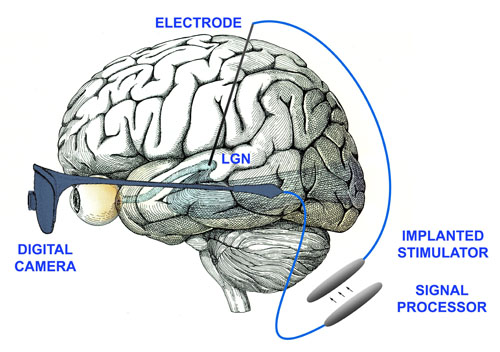Bionic Vision with Brain Implants
7 May, 2007 12:27 pm
Implants in the relay station of the visual brain may one day be able to restore sight to those blinded by eye disease. That's what suggests Harvard Medical School researchers John Pezaris and Clay Reid 's study on monkeys.
We used a simple but elegant experiment that allowed us to compare the animal's reactions to normal visual stimuli presented on a computer monitor against their reaction to stimuli presented through electrical stimulation. When prompted with points of light on a computer screen, the animals shifted their gaze to look at the corresponding position on the screen;
when prompted with electrical stimulation, the animals looked at what we conclude to be the location of an artificial, virtual point of light despite nothing appearing on the screen. The position of this artificial percept, or phosphene, could be accurately predicted from the precise placement of electrodes in the LGN.
What's the difference between this experiment and previous attempts in bionic vision?
While we did not achieve artificial vision by a long stretch, we did take the first step along a new avenue toward an eventual device. This first step is an important one, however, because of how promising our approach is. The primary difference between our approach and other previous -- and current -- approaches is where we are placing our stimulating electrodes. Other research groups are stimulating the retina or the primary visual cortex (V1). We placed our electrodes in the lateral geniculate nucleus of the thalamus, a relay station between the retina and V1. The LGN combines the best of both retinal and cortical approaches while avoiding most of the disadvantages of either. The largest disadvantage that the LGN approach has is the location of the area. Being part of midbrain, located in the middle of the head, it has been traditionally considered to be somewhat difficult access surgically. However, with advances made in the unrelated field of Deep Brain Stimulation where neurosurgeons have been able to place electrodes reliably and safely in deep structures, we are hopeful that surgical access to LGN will not be an insurmountable issue.
Do you plan to do clinical trials of visual prostheses on human in the near future?
Not in the near future. We must first increase the number of electrode counts and demonstrate basic safety of the electrodes in an animal model before we can propose initial pilot trials in humans. We hope to begin discussions for human trials of a primitive, simplified device in 2-3 years. It will be many more years before we have a functioning clinical device.

Figure : Pezaris JS and Reid RC, "Demonstration of Artificial Visual Percepts
Generated through Thalamic Microstimulation," PNAS 2007.
This illustration shows how a visual prosthesis might work someday. The patient would wear a special set of glasses with a small digital camera mounted in the lens. The camera would have a wire that communicates to an external signal processor, worn in a pocket or on a belt. The signal processor would translate the image from the camera into the neural impulses and transmit them wirelessly to an implanted stimulator. The stimulator would drive the electrode, surgically placed in the brain, delivering images to the visual system.
CREDIT: J. S. Pezaris adapted with permission from D. H. Hubel.
Interview by Clementine Fullias






